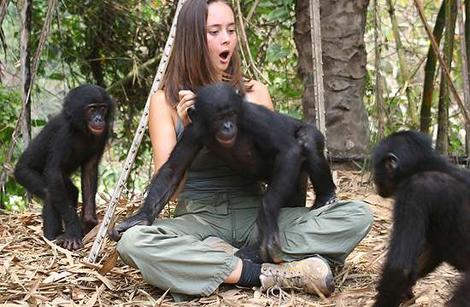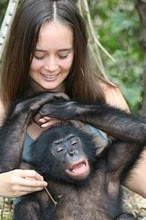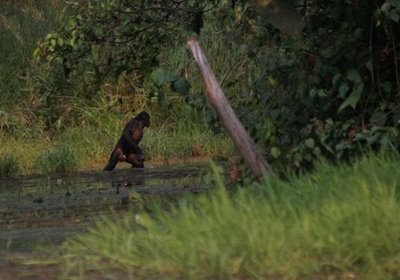Bigfoot and Bonobos
Posted by: Loren Coleman on October 1st, 2010

Bonobo expert Vanessa Woods is interested in Bigfoot. We have discussed her here before.



Recently, she revisited the issue of “Bonobos and Bigfoot,” at her Psychology Today blog. Here’s part of what she said.
Bonobos are becoming quite the rage in the bigfoot circles. In 2008, I had one of my bonobo photos stolen from my blog and entered into a Bigfoot photo competition….
So officially, I don’t think you can say for sure that there is 100% no Bigfoot. I’m willing to entertain the thought that Bigfoot might be out there. I’m not sure it’s very likely, but i’m not crossing it out….
I don’t think I’ll be able to drop bonobos and study Bigfoot. I don’t have enough time to whizzle as it is, much less take up another research subject….
We sent in this comment:
Vanessa,
We have the archive of your bonobo photo being used in the Field & Stream/Bushnell “Bigfoot” photography contest.
We at Cryptomundo are fans of your work.
Sincerely, Craig Woolheater & Loren Coleman
Cryptomundo
About Loren Coleman
Loren Coleman is one of the world’s leading cryptozoologists, some say “the” leading living cryptozoologist. Certainly, he is acknowledged as the current living American researcher and writer who has most popularized cryptozoology in the late 20th and early 21st centuries.
Starting his fieldwork and investigations in 1960, after traveling and trekking extensively in pursuit of cryptozoological mysteries, Coleman began writing to share his experiences in 1969. An honorary member of Ivan T. Sanderson’s Society for the Investigation of the Unexplained in the 1970s, Coleman has been bestowed with similar honorary memberships of the North Idaho College Cryptozoology Club in 1983, and in subsequent years, that of the British Columbia Scientific Cryptozoology Club, CryptoSafari International, and other international organizations. He was also a Life Member and Benefactor of the International Society of Cryptozoology (now-defunct).
Loren Coleman’s daily blog, as a member of the Cryptomundo Team, served as an ongoing avenue of communication for the ever-growing body of cryptozoo news from 2005 through 2013. He returned as an infrequent contributor beginning Halloween week of 2015.
Coleman is the founder in 2003, and current director of the International Cryptozoology Museum in Portland, Maine.











If Bigfoot were as sexually active as the Bonobos, we’d never get any sleep.
I sometimes wonder if bonobos aren’t a form of chimp that found an evolutionary advantage in having the social instincts it does
In which aggression is reduced and social cooperation is reinforced, in a somewhat similar way that those Siberian foxes when selected for reduced aggression were. In other words if the process of neotony was part of the process. I can likewise imagine a similar scenario of differing populations of ancestral proto humans might have self selected for characteristics that bequeathed to them advantages particular to their experience within their habitat…one population retaiining it’s pre-social adrenal levels and anotherfsa population finding that those who could tolerate larger groups due to reduced or latent levels of adrenal hormones could cooperate and function better in protecting their group and it’s resources.
It would be fascinating to see how chimps, if selected for being less aggressive were to begin displaying the more gracile morphology, rounded foreheads, and more matriarchal social dominance we associate with the nursery.
Man, I need to have my head examined. The minute I read “Bigfoot & Bonobos” (followed by that accompanying image) my mind deleted certain letters from the last word @_@
dogu4: interesting speculation. I’d never thought about it before.
One theory on the domestication of the dog is that humans didn’t domesticate them so much as they did themselves. Animals with a genetic mutation conferring similar characteristics to the foxes you mention may have not only exhibited different physical characteristics but also a reduced aversion to humans…of which both species quickly took advantage. Read this article (fascinating for other reasons as well) for more:
http://www.carolinadogs.com/smithsonian.html
SPOILER ALERT/CUTTING TO THE CHASE DEPT.
Here’s the theory in a nutshell, explained in much more detail in the article:
“Fear is controlled, in part, by the adrenal gland, and adrenaline production, in turn, is one of the many biological functions controlled by thyroxine.
“In Crockford’s view, the less fearful wolves would thrive near settlements, scavenging garbage middens and filching meat from drying racks, breeding among themselves and reinforcing those attributes. Natural selection would favor canids with thyroxine levels that produce lower adrenal response. Any pups born with a more fearful nature would simply drift away from the villages, back into the wilderness. After just a few generations, she believes, the wolves living near humans would exhibit reproductive, physical and behavioral differences, triggered by their new thyroxine patterns, that would set them apart from their wilder counterparts. They would have become primitive dogs. Only much later, long after primitive dogs had become genetically distinct and reproductively isolated from wolves, did humans begin exerting artificial selection to create distinct breeds.”
But read the article. Pretty fascinating stuff.
Agree with red_pill… if I didn’t know better, I’d have cried shenanigans with that wordplay/image combination. Silly me!
🙂
Dogu4- The intricacies of behavioral evolution is a fascinating topic to discuss. I will say that the morphology and things such as the rounded foreheads may not necessarily be a requisite feature nor an effect of evolving in the manner which you described.
It is often thought that evolution is a pretty straightforward process, with mutations being either selected for or selected against, with no gray area and no physical or behavioral feature without some sort of larger purpose. However, that is not always the case. You can have mutations that are beneficial in some way, others which are detrimental, and then you get those which are neutral. These are the mutations that are neither good or bad for the organism, and with nothing selecting for or against them, you can have these characteristics sticking around with no real purpose or deeper meaning other than they were not influenced by selective pressures. Examples abound of neutral mutations and there are many physical characteristics that exist with no particular function in the survival of the creatures possessing them.
In short, things like the more rounded foreheads may be there “just because.” Still, interesting idea. Just thought I’d throw that out there.
I love that photo that Vanessa took that was ripped off. It’s easy to see why someone thought that it could fill in as a Sasquatch photo.
DWA and Mystery Man, you guys are way long winded. Even when you agree with someone’s statemants. What do you guys do for a living?